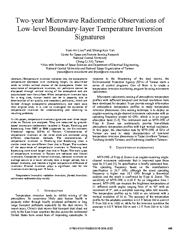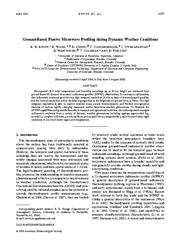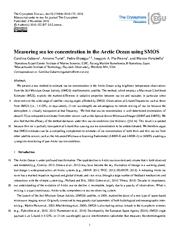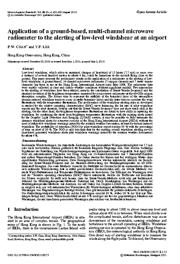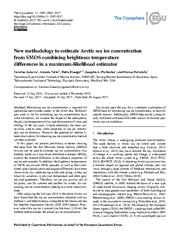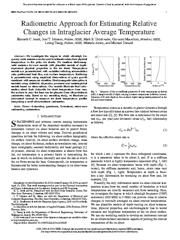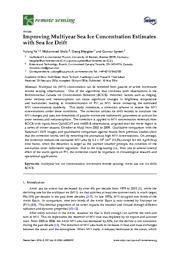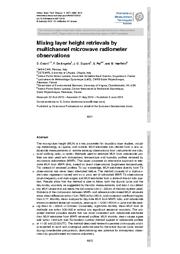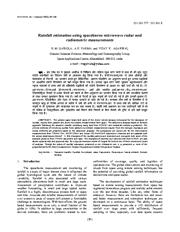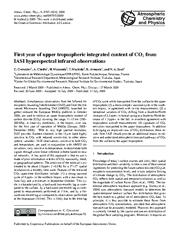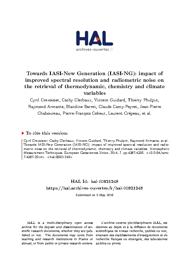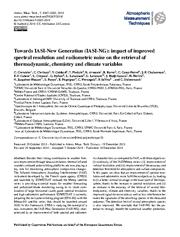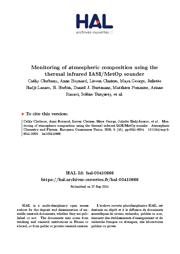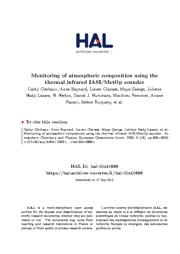A copy of this work was available on the public web and has been preserved in the Wayback Machine. The capture dates from 2016; you can also visit the original URL.
The file type is application/pdf.
Filters
Two-year Microwave Radiometric Observations of Low-level Boundary-layer Temperature Inversion Signatures
2006
2006 IEEE International Symposium on Geoscience and Remote Sensing
In this paper, temperature inversion signatures over three major cities on Taiwan are analyzed. ...
Temperature inversion; radiation inversion; frontal inversion; microwave radiometer (key words) I. 0-7803-9510-7/06/$20.00 ...
ACKNOWLEDGMENT The authors are grateful to the EPA and National Science Council (NSC) of Taiwan for providing financial supports to this research under grants EPA92-L102-02-208 and NSC 94-2111-M-008-008 ...
doi:10.1109/igarss.2006.169
dblp:conf/igarss/LiouY06
fatcat:a3jci2dsyve2fns64l2topfevi
Ground-Based Passive Microwave Profiling during Dynamic Weather Conditions
2009
Journal of Atmospheric and Oceanic Technology
Short-period (1-5 min) temperature and humidity soundings up to 10-km height are retrieved from ground-based 12-channel microwave radiometer profiler (MWRP) observations. ...
upslope supercooled fog, snowfall, a complex cold front, a nocturnal bore, and a squall line accompanied by a wake low and other rapid variations in low-level water vapor and temperature. ...
One of the authors (RW) acknowledges support from U.S. Army Research Laboratory Contract DAAD17-01-C-0045 (E. Measure, Program Manager). ...
doi:10.1175/2008jtecha1150.1
fatcat:7s65mdbwjnhuzdg5tak75bjjiq
Measuring sea ice concentration in the Arctic Ocean using SMOS
2016
The Cryosphere Discussions
We present a new method to estimate sea ice concentration in the Arctic Ocean using brightness temperature observations from the Soil Moisture Ocean Salinity (SMOS) interferometric satellite. ...
We therefore argue that SMOS estimates can be a compelling complement to estimates of ice concentration of both thick and thin sea ice from other satellite sensors such as the Advanced Microwave Scanning ...
season, the observed radiometric signature change. ...
doi:10.5194/tc-2016-175
fatcat:vh3thzpnnvccdfnonnhktw5xrm
Application of a ground-based, multi-channel microwave radiometer to the alerting of low-level windshear at an airport
2011
Meteorologische Zeitschrift
Two approaches to the alerting of windshear have been studied, namely, the calculation of Brunt-Vaisala frequency and the standard deviation of the brightness temperature measured by a microwave radiometer ...
The former tries to represent the stability of the boundary layer of the atmosphere (terrain-induced windshear tends to occur in stable boundary layer) and the latter tries to correlate the wind fluctuations ...
/temperature inversions in the lowest part and in the topmost part of the boundary-layer temperature profile. ...
doi:10.1127/0941-2948/2011/0275
fatcat:7yi53m2lj5avzcaoxicgpqrzc4
New methodology to estimate Arctic sea ice concentration from SMOS combining brightness temperature differences in a maximum-likelihood estimator
2017
The Cryosphere
However, the potential of satellite L-band observations for obtaining sea ice concentration had not yet been explored. ...
In the last years, L-band radiometry has been successfully used to study some properties of sea ice, remarkably sea ice thickness. ...
This study has been funded by the national R&D program of the Spanish Ministry of Economy and FEDER/EU fund through the PROMISES project (ESP2015-67549-C3-R), as well as by previous SMOS-related grants ...
doi:10.5194/tc-11-1987-2017
fatcat:a4dq5m2fsvdcpiuveyzfvtexfm
Radiometric Approach for Estimating Relative Changes in Intraglacier Average Temperature
2015
IEEE Transactions on Geoscience and Remote Sensing
Scattering is parameterized using empirical observations of grain growth combined with measured densities. ...
We combine electromagnetic emission forward models with plausible models of depthdependent physical properties in the ice sheet. ...
ACKNOWLEDGMENT The authors would like to thank the editor and two reviewers for the many helpful comments. SMOS data sets were provided by the European Space Agency. CSA ...
doi:10.1109/tgrs.2014.2319265
fatcat:3txqfv2gprdxziunesooglcxzu
Improving Multiyear Sea Ice Concentration Estimates with Sea Ice Drift
2016
Remote Sensing
anomalous snow radiometric signature. ...
In late 1970s, MYI occupied two thirds of the Arctic Basin. In comparison, over two thirds of the Arctic Basin is now covered by first-year ice (FYI) [8, 9] . ...
Acknowledgments: Radarsat-1 data from the Alaska Satellite Facility, and the enhanced AMSR-E and QuikSCAT data from the Microwave Earth Remote Sensing Research Group, Brigham Young University, are gratefully ...
doi:10.3390/rs8050397
fatcat:h3a3amblrzflvnc54fmc5u5u54
Mixing layer height retrievals by multichannel microwave radiometer observations
2013
Atmospheric Measurement Techniques
</strong> The mixing layer height (MLH) is a key parameter for boundary layer studies, including meteorology, air quality, and climate. ...
This paper proposes an alternative approach to estimate MLH from MWR data, based on direct observations (brightness temperatures, Tb) instead of retrieved profiles. ...
Part of this work has been stimulated through the EU COST Action ES0702 EG-CLIMET. ...
doi:10.5194/amt-6-2941-2013
fatcat:sijb4utkfrdizlyxwpnojczm7q
Rainfall estimation using spaceborne microwave radar and radiometric measurements
2022
Mausam
The inverse methods of retrieving rainfall from satellite microwave measurements mainly from the multiple regression and neural networks are presented based on the sensitivity analysis. ...
The simulations are carried out for the multichannel measurements from TRMM-TMI, DMSP-SSM/I and Indian IRS-P4-MSMR radiometric channels and are assessed with the actual observations thereof. ...
The data of TRMM, SSM/I and T/P used in the study from NASA/GSFC is thankfully acknowledged. We thank unanimous reviewer for providing very good suggestions to improve the quality of the paper. ...
doi:10.54302/mausam.v54i1.1494
fatcat:l2lbij7nfrcj5hyq7qpx3bp5by
First year of upper tropospheric integrated content of CO2 from IASI hyperspectral infrared observations
2009
Atmospheric Chemistry and Physics
IASI observations, sensitive to both CO 2 and temperature, are used in conjunction with AMSU observations, only sensitive to temperature, to decorrelate both signals through a non-linear inference scheme ...
aircraft measurements; (4) signatures of CO 2 emissions transported to the upper troposphere. ...
Richter The publication of this article is financed by CNRS-INSU. ...
doi:10.5194/acp-9-4797-2009
fatcat:we652lnwezd25co3wjzwk5y7ci
Mixing layer height retrievals by multichannel microwave radiometer observations
2013
Atmospheric Measurement Techniques Discussions
The mixing layer height (MLH) is a key parameter for boundary layer studies, including meteorology, air quality, and climate. ...
MLH estimates are inferred from in situ radiosonde measurements or remote sensing observations from instruments like lidar, wind profiling radar, or sodar. ...
Part of this work has been stimulated through the EU COST Action ES0702 EG-CLIMET. ...
doi:10.5194/amtd-6-4971-2013
fatcat:cewgj74fknbeblsyndznhdnkvy
Towards IASI-New Generation (IASI-NG): impact of improved spectral resolution and radiometric noise on the retrieval of thermodynamic, chemistry and climate variables
2014
Atmospheric Measurement Techniques
well as less interference between the signatures of the absorbing species in the measured radiances. ...
In this paper, we show that an improvement of spectral resolution and radiometric noise fulfil these objectives by leading to (i) a better vertical coverage in the lower part of the troposphere, thanks ...
Calculations were performed at IDRIS, the computer centre of CNRS, and at ClimServ, the data and computer centre of IPSL.
Edited by: A. ...
doi:10.5194/amt-7-4367-2014
fatcat:vup3dqskhndpbbx7m2zgzlwvji
Towards IASI-New Generation (IASI-NG): impact of improved spectral resolution and radiometric noise on the retrieval of thermodynamic, chemistry and climate variables
2013
Atmospheric Measurement Techniques Discussions
well as less interference between the signatures of the absorbing species in the measured radiances. ...
In this paper, we show that an improvement of spectral resolution and radiometric noise fulfil these objectives by leading to (i) a better vertical coverage in the lower part of the troposphere, thanks ...
Calculations were performed at IDRIS, the computer centre of CNRS, and at ClimServ, the data and computer centre of IPSL.
Edited by: A. ...
doi:10.5194/amtd-6-11215-2013
fatcat:wt72daxt7raa5ajw232ihjhbia
Monitoring of atmospheric composition using the thermal infrared IASI/MetOp sounder
2009
Atmospheric Chemistry and Physics Discussions
The IASI nadir looking thermal infrared sounder onboard MetOp will provide 15 years of global scale observations for a series of key atmospheric species, with unprecedented spatial sampling and coverage ...
Atmospheric remote sounding from satellites is an essential component of the observational strategy deployed to monitor atmospheric pollution and changing composition. ...
The IASI mission is a joint mission of Eumetsat and the Centre National d'Etudes Spatiales (CNES, France). ...
doi:10.5194/acpd-9-8307-2009
fatcat:hguq67v6tjbbbmw7egzhvtljtm
Monitoring of atmospheric composition using the thermal infrared IASI/MetOp sounder
2009
Atmospheric Chemistry and Physics
The IASI nadir looking thermal infrared sounder onboard MetOp will provide 15 years of global scale observations for a series of key atmospheric species, with unprecedented spatial sampling and coverage ...
Atmospheric remote sounding from satellites is an essential component of the observational strategy deployed to monitor atmospheric pollution and changing composition. ...
The IASI mission is a joint mission of Eumetsat and the Centre National d'Etudes Spatiales (CNES, France). ...
doi:10.5194/acp-9-6041-2009
fatcat:cd7me36yq5akdenkx5mqzzwfxi
« Previous
Showing results 1 — 15 out of 671 results

